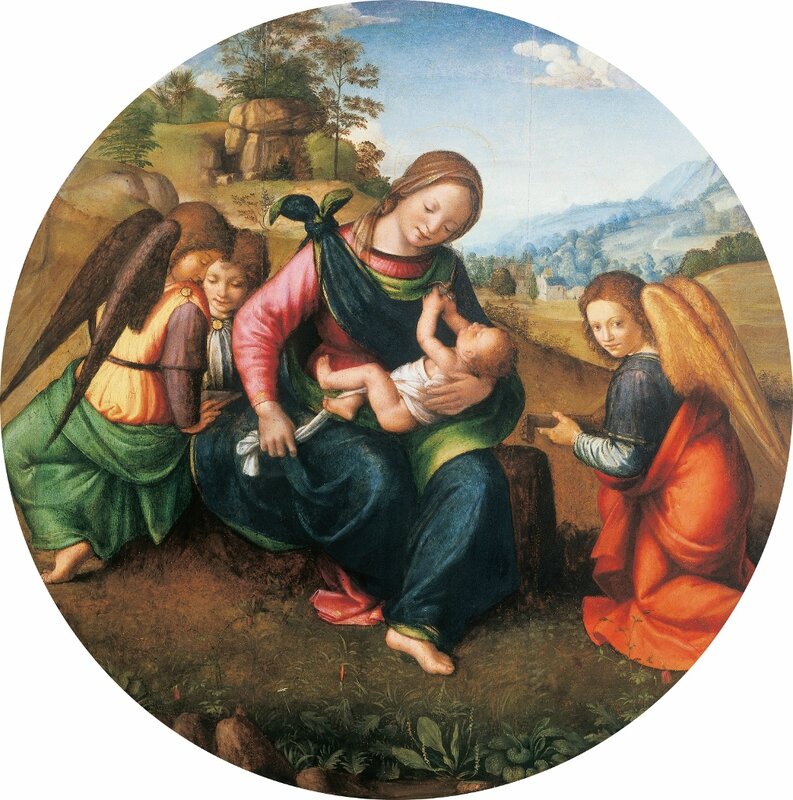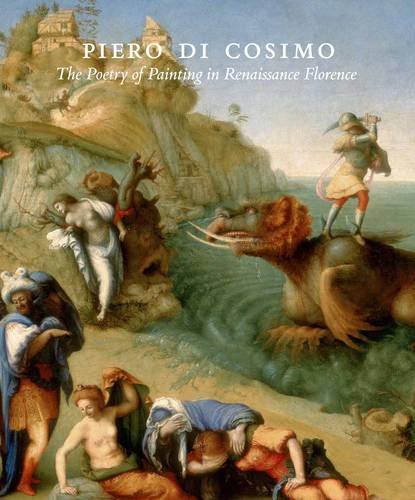Once-in-a-Lifetime Piero di Cosimo Retrospective Premieres at National Gallery of Art, Washington, February 1–May 3, 2015;
Travels to Galleria degli Uffizi, Florence, June 23–September 27, 2015
![Piero di Cosimo, The Visitation with Saint Nicholas and Saint Anthony Abbot, c. 1489/1490, oil on panel, 184.2 x 188.6 cm (72 1/2 x 74 1/4 in.), National Gallery of Art, Washington, Samuel H. Kress Collection Piero di Cosimo, The Visitation with Saint Nicholas and Saint Anthony Abbot, c. 1489/1490, oil on panel, 184.2 x 188.6 cm (72 1/2 x 74 1/4 in.), National Gallery of Art, Washington, Samuel H. Kress Collection]()
Exhibition Highlights
Showcased throughout six galleries in the West Building, the paintings on view will include altarpieces, images for private devotion, portraits, and mythological and allegorical scenes—some produced as a series and reunited for the exhibition.
Several religious works influenced by Leonardo, such as the
Madonna and Child with Two Musician Angels (c. 1504–1507, Cini Collection),
will be on view alongside Piero's fanciful mythological inventions, including the renowned
Liberation of Andromeda (c. 1510–1513, Uffizi).
For many prominent families in Renaissance Florence, from the Capponi to the Strozzi, Piero created elaborate fables and singular mythological fantasies, the meanings of which continue to puzzle scholars. A strange and whimsical painting,
The Discovery of Honey (c. 1500, Worcester Art Museum),
will be reunited with
The Misfortunes of Silenus (c. 1500, Harvard Art Museums).
The Hunt
and The Return from the Hunt (both c. 1485–1500, The Metropolitan Museum of Art)
illustrate a struggle for survival between man, satyrs, and wild beasts, with the distinctions not altogether clear among them.
Another of Piero's best-known spalliera panels (paintings set into the wall as wainscoting at about shoulder height, or on large pieces of furniture)—
Construction of a Palace (c. 1514–1518, Ringling Museum of Art)—
will be on view, along with compelling portraits, including likenesses of the famed architect Giuliano da Sangallo and his father Francesco Giamberti (both c. 1482/1483, Rijksmuseum).
Four paintings will be on view only in Washington:
Vulcan and Aeolus (c. 1490, National Gallery of Canada, Ottawa),
Madonna and Child with Saints Dominic, Nicholas of Bari, Peter, and John the Baptist (Pala del Pugliese) (c. 1481–1485, Saint Louis Art Museum),
Madonna and Child with Saints John the Baptist, Margaret, Martin, and Angels (c. 1515–1518, Philbrook Museum of Art, Tulsa),
and one intimately scaled work attributed to Piero,
Saint Veronica (c. 1510, private collection).
Piero di Cosimo (1462–1522)
As a pupil of Cosimo Rosselli, Piero di Cosimo began his career around 1480. A painter of the Florentine School and a contemporary of Botticelli, Leonardo, and Michelangelo, Piero was known in his day for his versatility as a painter of many different subjects, from the sacred to the profane, the latter often of beguiling meaning.
"His fantastic inventions rivaled the verses of the ancient poets whose myths and allegories he set out to transform in a wonderfully strange language all his own," said Gretchen Hirschauer, associate curator of Italian and Spanish paintings, National Gallery of Art.
The first and only exhibition on Piero di Cosimo in the United States was held in 1938 at the Schaeffer Galleries, New York, and included seven paintings attributed to the artist.
Curators and Catalogue
The curators of the exhibition in Washington are Gretchen Hirschauer, associate curator of Italian and Spanish paintings, National Gallery of Art; and Dennis Geronimus, associate professor of Italian Renaissance art history, New York University; assisted by Virginia Brilliant, The Ulla R. Searing Curator of Collections at The John and Mable Ringling Museum of Art, Sarasota, Florida; and Elizabeth Walmsley, painting conservator, National Gallery of Art. At the Uffizi, the curators include Daniela Parenti, head of the department of medieval to quattrocento art, Uffizi; Serena Padovani, former director, Galleria Palatina, Palazzo Pitti; and independent scholar Elena Capretti, under the guidance of Uffizi director Antonio Natali.
A fully illustrated scholarly catalogue in English will accompany the exhibition in Washington. Essays and catalogue entries on each exhibition object have been written by Brilliant, Geronimus, Hirschauer, Padovani, and Walmsley, in addition to David Franklin, independent scholar; Alison Luchs, curator of early European sculpture, National Gallery of Art; Duncan Bull, curator of international paintings at the Rijksmuseum, Amsterdam; and Federica Zalabra, art historian, Galleria Nazionale dell'Umbria, Perugia. Relying on close formal, technical, and textual analysis, the authors not only argue for specific interpretations and cases of authorship but also address the social and religious functions of image making in the period.
Travels to Galleria degli Uffizi, Florence, June 23–September 27, 2015

Piero di Cosimo
The Visitation with Saint Nicholas and Saint Anthony Abbot, c. 1489/1490
oil on panel, 184.2 x 188.6 cm (72 1/2 x 74 1/4 in.)
National Gallery of Art, Washington, Samuel H. Kress Collection
The first major retrospective exhibition ever presented of paintings by the imaginative Italian Renaissance master Piero di Cosimo (1462–1522) will premiere at the National Gallery of Art, Washington, from February 1 through May 3, 2015. Piero di Cosimo: The Poetry of Painting in Renaissance Florence will showcase some 44 of the artist's most compelling works. With themes ranging from the pagan to the divine, the works include loans from churches in Italy and one of his greatest masterpieces, Madonna and Child Enthroned with Saints Elizabeth of Hungary, Catherine of Alexandria, Peter, and John the Evangelist with Angels (completed by 1493), from the Museo degli Innocenti, Florence. Several important paintings will undergo conservation treatment before the exhibition, including the Gallery's Visitation with Saints Nicholas of Bari and Anthony Abbot (c. 1489–1490)—one of the artist's largest surviving works.The Visitation with Saint Nicholas and Saint Anthony Abbot, c. 1489/1490
oil on panel, 184.2 x 188.6 cm (72 1/2 x 74 1/4 in.)
National Gallery of Art, Washington, Samuel H. Kress Collection
Exhibition Highlights
Showcased throughout six galleries in the West Building, the paintings on view will include altarpieces, images for private devotion, portraits, and mythological and allegorical scenes—some produced as a series and reunited for the exhibition.
Several religious works influenced by Leonardo, such as the
Madonna and Child with Two Musician Angels (c. 1504–1507, Cini Collection),
will be on view alongside Piero's fanciful mythological inventions, including the renowned
Liberation of Andromeda (c. 1510–1513, Uffizi).
For many prominent families in Renaissance Florence, from the Capponi to the Strozzi, Piero created elaborate fables and singular mythological fantasies, the meanings of which continue to puzzle scholars. A strange and whimsical painting,
The Discovery of Honey (c. 1500, Worcester Art Museum),
will be reunited with
The Misfortunes of Silenus (c. 1500, Harvard Art Museums).
The Hunt
and The Return from the Hunt (both c. 1485–1500, The Metropolitan Museum of Art)
illustrate a struggle for survival between man, satyrs, and wild beasts, with the distinctions not altogether clear among them.
Another of Piero's best-known spalliera panels (paintings set into the wall as wainscoting at about shoulder height, or on large pieces of furniture)—
Construction of a Palace (c. 1514–1518, Ringling Museum of Art)—
will be on view, along with compelling portraits, including likenesses of the famed architect Giuliano da Sangallo and his father Francesco Giamberti (both c. 1482/1483, Rijksmuseum).
Four paintings will be on view only in Washington:
Vulcan and Aeolus (c. 1490, National Gallery of Canada, Ottawa),
Madonna and Child with Saints Dominic, Nicholas of Bari, Peter, and John the Baptist (Pala del Pugliese) (c. 1481–1485, Saint Louis Art Museum),
Madonna and Child with Saints John the Baptist, Margaret, Martin, and Angels (c. 1515–1518, Philbrook Museum of Art, Tulsa),
and one intimately scaled work attributed to Piero,
Saint Veronica (c. 1510, private collection).
Piero di Cosimo (1462–1522)
As a pupil of Cosimo Rosselli, Piero di Cosimo began his career around 1480. A painter of the Florentine School and a contemporary of Botticelli, Leonardo, and Michelangelo, Piero was known in his day for his versatility as a painter of many different subjects, from the sacred to the profane, the latter often of beguiling meaning.
"His fantastic inventions rivaled the verses of the ancient poets whose myths and allegories he set out to transform in a wonderfully strange language all his own," said Gretchen Hirschauer, associate curator of Italian and Spanish paintings, National Gallery of Art.
The first and only exhibition on Piero di Cosimo in the United States was held in 1938 at the Schaeffer Galleries, New York, and included seven paintings attributed to the artist.
Curators and Catalogue
The curators of the exhibition in Washington are Gretchen Hirschauer, associate curator of Italian and Spanish paintings, National Gallery of Art; and Dennis Geronimus, associate professor of Italian Renaissance art history, New York University; assisted by Virginia Brilliant, The Ulla R. Searing Curator of Collections at The John and Mable Ringling Museum of Art, Sarasota, Florida; and Elizabeth Walmsley, painting conservator, National Gallery of Art. At the Uffizi, the curators include Daniela Parenti, head of the department of medieval to quattrocento art, Uffizi; Serena Padovani, former director, Galleria Palatina, Palazzo Pitti; and independent scholar Elena Capretti, under the guidance of Uffizi director Antonio Natali.
A fully illustrated scholarly catalogue in English will accompany the exhibition in Washington. Essays and catalogue entries on each exhibition object have been written by Brilliant, Geronimus, Hirschauer, Padovani, and Walmsley, in addition to David Franklin, independent scholar; Alison Luchs, curator of early European sculpture, National Gallery of Art; Duncan Bull, curator of international paintings at the Rijksmuseum, Amsterdam; and Federica Zalabra, art historian, Galleria Nazionale dell'Umbria, Perugia. Relying on close formal, technical, and textual analysis, the authors not only argue for specific interpretations and cases of authorship but also address the social and religious functions of image making in the period.

.jpg)








